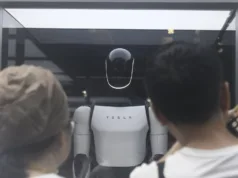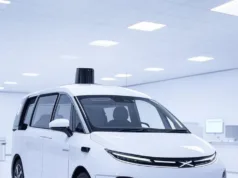
SHANGHAI—Tesla Inc. has made a bold entrance into China’s fiercely competitive autonomous vehicle market with the debut of its Robotaxi service, captivating eager auto enthusiasts and signaling a potential resurgence for the electric vehicle giant in the world’s largest car market. The unveiling, which took place over the weekend at the China International Import Expo in Shanghai, marks the first time Tesla’s Cybercab has been showcased in the country, drawing massive crowds and reigniting interest in Elon Musk’s vision for self-driving taxis.
According to TipRanks.com, the event has positioned Tesla to ‘steal back market share in China’ after unveiling the robotaxi service for the first time. The Cybercab, a sleek, two-seater autonomous vehicle without a steering wheel or pedals, represents Tesla’s push into full self-driving technology, a domain where Chinese rivals have already established strong footholds.
Navigating Regulatory Waters
Tesla’s foray into China comes amid a complex regulatory landscape for autonomous vehicles. Elon Musk first proposed testing Tesla’s advanced driver-assistance package in China during a visit in April 2024, as reported by Reuters. The proposal involved deploying it in robotaxis, and while China has shown partial support, full implementation of Tesla’s Full Self-Driving (FSD) software remains pending approval.
Recent developments indicate progress: Tesla is now running pilot Robotaxi operations in China, with reports of testing in cities like Shanghai and Hangzhou. A post on X from user Herbert Ong highlighted that ‘Shanghai is letting 10 TSLA cars test their FSD software, a big step towards robotaxis in China,’ based on information from 2024. This testing is crucial as China has defined processes for autonomous vehicles on public roads through local legislation, making it a testing ground for global players.
Competition Heats Up in the East
However, Tesla faces stiff competition from homegrown Chinese companies that have been aggressively developing and deploying robotaxi services. Firms like Baidu and Pony.ai are already operating autonomous vehicles in select cities, with Baidu announcing in 2021 plans to produce robotaxis for around $77,665 each, as noted in Wikipedia. IEEE Spectrum reports that ‘Tesla’s robotaxi debut in Austin got people excited. But can the company compete on the global stage with Chinese AV giants like Baidu and Pony.ai?’ in an article dated July 15, 2025.
Rival Xpeng is also advancing rapidly, announcing collaborations for its own Robotaxi launch in 2026. According to a news update from Longbridge, ‘On November 5th, at XPeng Technology Day, XPeng Motors Chairman and CEO He Xiaopeng announced that Amap has become the first global ecological partner for XPeng Robotaxi.’ This partnership aims to integrate Xpeng’s services with mapping platforms, potentially expanding to overseas markets.
Technological Edge and Production Plans
Tesla’s Cybercab is designed for mass production, with plans to begin in the second quarter of 2026. By the end of 2025, Tesla aims to have 500 units in Austin and 1,000 in the Bay Area, as shared in a post on X by Gasgoo Auto News. The vehicle relies on a pure-vision solution without lidar, featuring a dual-redundancy safety architecture, which aligns with Tesla’s camera-based autonomous driving approach.
Elon Musk has discussed a sub-$25,000 Tesla Robotaxi, and the company is designing an assembly line to accommodate it, per Wikipedia. In China, Tesla’s Giga Shanghai factory is already 95% automated, capable of producing one car every 30 seconds, as mentioned in an X post by Herbert Ong citing Tesla executives. This production prowess could give Tesla an edge in scaling Robotaxi fleets.
Market Dynamics and Consumer Response
The debut at the Shanghai Expo has generated significant buzz, with Tesla’s Vice President Tao Lin announcing the Cybercab’s Asia-Pacific debut via Weibo, as reported by Reuters on October 30, 2025. Finance Yahoo noted that the event marks Tesla’s return to the world’s largest import trade fair after skipping previous editions, showcasing the Robotaxi amid growing domestic competition.
Chinese auto fans have responded enthusiastically, with TipRanks.com describing them as ‘eager’ and predicting a market share recovery for Tesla. However, operating costs remain a key factor: Wikipedia estimates robotaxi costs at around $0.30 per mile, excluding support staff, which is competitive but requires regulatory green lights for widespread adoption.
Strategic Partnerships and Expansions
Tesla’s strategy in China includes partnerships, such as with Baidu for maps and navigation, which moved self-driving capabilities closer in 2024, according to an X post by Radar Hits citing Bloomberg. This collaboration is essential for navigating China’s urban environments and complying with local data regulations.
Looking ahead, Tesla envisions a hybrid model where company-owned fleets operate like Uber, and customer-owned cars can join the network, as outlined in an X post by Herbert Ong. This could democratize Robotaxi access, but it hinges on approvals for unsupervised FSD, which Musk expects in early 2026, per an X post by Ian Pitchford.
Challenges in a Crowded Field
Despite the excitement, challenges abound. Chinese regulations limit driverless operations to gated zones with quotas and time limits, as noted in an X post by Niels Pluijmen discussing rival WeRide. Tesla must navigate these restrictions while competing against established players like Baidu, whose Apollo Go service is already operational in multiple cities.
Moreover, Tesla’s stock has seen fluctuations tied to these developments. An X post by Ken highlighted a recent dip but emphasized positive aspects like the 821km Model Y in China and five-city Robotaxi expansion, framing it as the ‘beginning of’ a larger story. Analysts from TipRanks.com see the Cybercab debut as a catalyst for stock recovery.
Global Implications for Autonomous Tech
On a broader scale, Tesla’s push in China could influence global autonomous driving standards. With China leading in AV testing—several companies are trialing services in the US and China, per Wikipedia—the outcomes here may shape regulations worldwide.
Elon Musk’s vision, as proposed in state media reports via Reuters, positions Robotaxis as a key to sustainable transport. Yet, as IEEE Spectrum questions, competing with Chinese giants will test Tesla’s technological and operational mettle in this high-stakes market.
Innovation Amid Rivalry
Xpeng’s recent AI innovations, unveiled just as Tesla’s Cybercab landed in China, add to the rivalry, according to TechTimes on October 31, 2025. Xpeng plans mass production of humanoid robots alongside its Robotaxi, signaling a multifaceted approach to autonomy.
Tesla, in response, is leveraging its FSD advancements. Posts on X from Herbert Ong reveal executive insights, such as Tesla seeking permission for Robotaxi tests in Shanghai, underscoring the company’s commitment to rapid iteration.
Future Horizons for Tesla in China
As Tesla ramps up, the integration of Robotaxi with existing ride-hailing ecosystems will be pivotal. Partnerships like Xpeng’s with Amap, as per Longbridge, highlight the importance of local alliances, which Tesla may need to emulate.
Ultimately, the debut represents a pivotal moment for Tesla, blending innovation with market strategy in a region critical to its global ambitions. With production scaling and regulatory hurdles in sight, the coming months will determine if Tesla can truly conquer China’s autonomous frontier.









